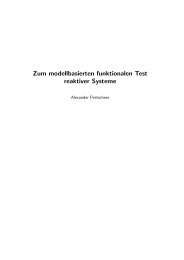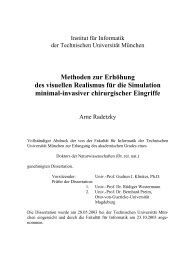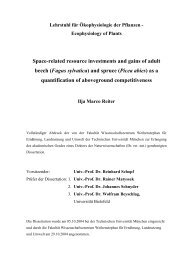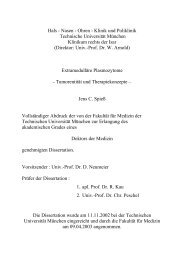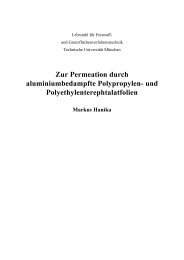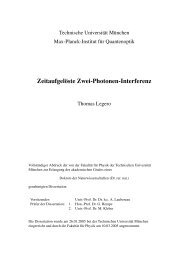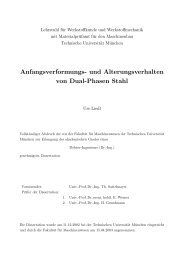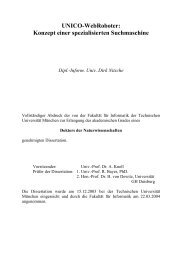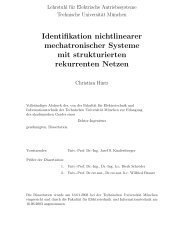Topologically Defined Neuronal Networks Controlled by Silicon Chips
Topologically Defined Neuronal Networks Controlled by Silicon Chips
Topologically Defined Neuronal Networks Controlled by Silicon Chips
Create successful ePaper yourself
Turn your PDF publications into a flip-book with our unique Google optimized e-Paper software.
CHAPTER 2. NETWORKS OF DEFINED TOPOGRAPHY<br />
Figure 2.6: Schematic illustration of the patterning procedure.<br />
2.3.1 Patterns of growth-promoting proteins<br />
Tracks of intact extracellular matrix proteins (ECM) surrounded <strong>by</strong> UV-inactivated areas have shown<br />
to reliably guide growing leech neurites [35]. This technique has been adapted to the requirements of<br />
Lymnaea neuronal cell culture <strong>by</strong> A. Prinz [79]. Instead of ECM, substrate-adsorbed material (SAM)<br />
is patterned with UV light. The procedure involves the following steps, which are also illustrated in fig.<br />
2.6:<br />
– deposit a layer of SAM on glass coverslips as described in section 2.2.2<br />
– remove conditioning brains, supernatant and flexiPERM adhesive culture chambers (in vitro Systems<br />
& Services, Osterode, Germany) and dry the coated coverslips in a sterile flow hood<br />
– 20min exposure to the full spectrum of a 200W mercury lamp (Osram HBO 200, intensity of the<br />
366nm-line approximately 170mW/cm 2 ) through a lithographic mask in direct contact with the<br />
proteinacious layer<br />
– remove the mask and rinse with defined medium to wash away denatured protein from exposed<br />
areas<br />
– attach flexiPERM chamber and refill with DM or a 1:1 mixture of DM and supernatant<br />
– place neurons on the patterned substrate and cultivate for two to three days<br />
Masks consist of 1mm-2mm thick silica plates transparent to UV light. They are coated with a thin but<br />
nontransparent layer of aluminum into which the desired patterns are etched [35].<br />
To avoid any contamination, the entire procedure, including UV exposure, is carried out under a sterile<br />
flowhood and the masks are immersed in a solution of 70% ethanol and 30% water for 30min prior to<br />
use.<br />
2.3.2 Topographic structures<br />
The first topographic structures were made from the n-type polyimide photoresist HTR3-200 (Olin<br />
GmbH, Munich, Germany) processed onto glass coverslips and pieces of Si-wafers. Process parameters<br />
and steps are similar to those described in [129]. Although compatible with cell culture and resistant<br />
to all cleaning procedures, including the short application of piranha solution (see 2.2.3), structures<br />
made from polyimide are not satisfactory. Resolution and feature accuracy is poor, especially for deep,<br />
narrow grooves with aspect ratios of 2 or higher (ratio of structure height to width). Also polyimide<br />
layers of 10µm thickness or more detach frequently at the sides of the grooves, leaving a gap between<br />
substrate and resist into which neurites can grow; as shown in fig. 2.7. Due to these limitations, HTR3-<br />
200 is not used any more for making topographic structures directly in contact with cell culture.<br />
Nevertheless, thin polyimide layers with well resolved features are ideally suited as sacrificial masks<br />
for etching the structure directly into the substrate underneath. However, the RIE80 Plasmalab etcher<br />
(Oxford Instruments) available in the departmental cleanroom facility cannot etch silicon anisotropically.<br />
Walls of grooves are not vertical but inclined, reducing the directional information drastically,<br />
with many neurites leaving the guidance structure. Etching topographic structures directly into the substrate<br />
was not followed any further, even though there are ways to process vertical walls into silicon,<br />
16


